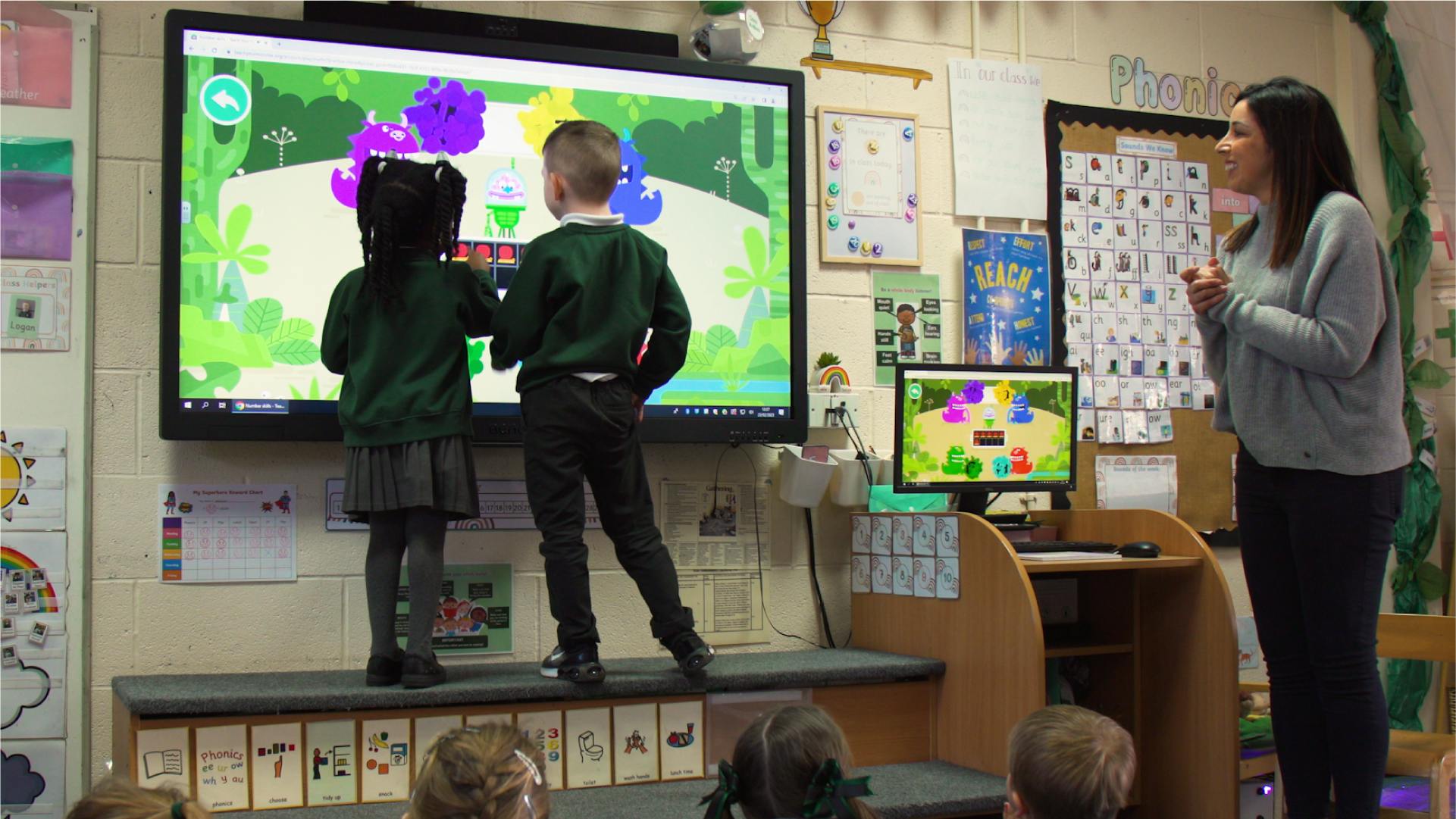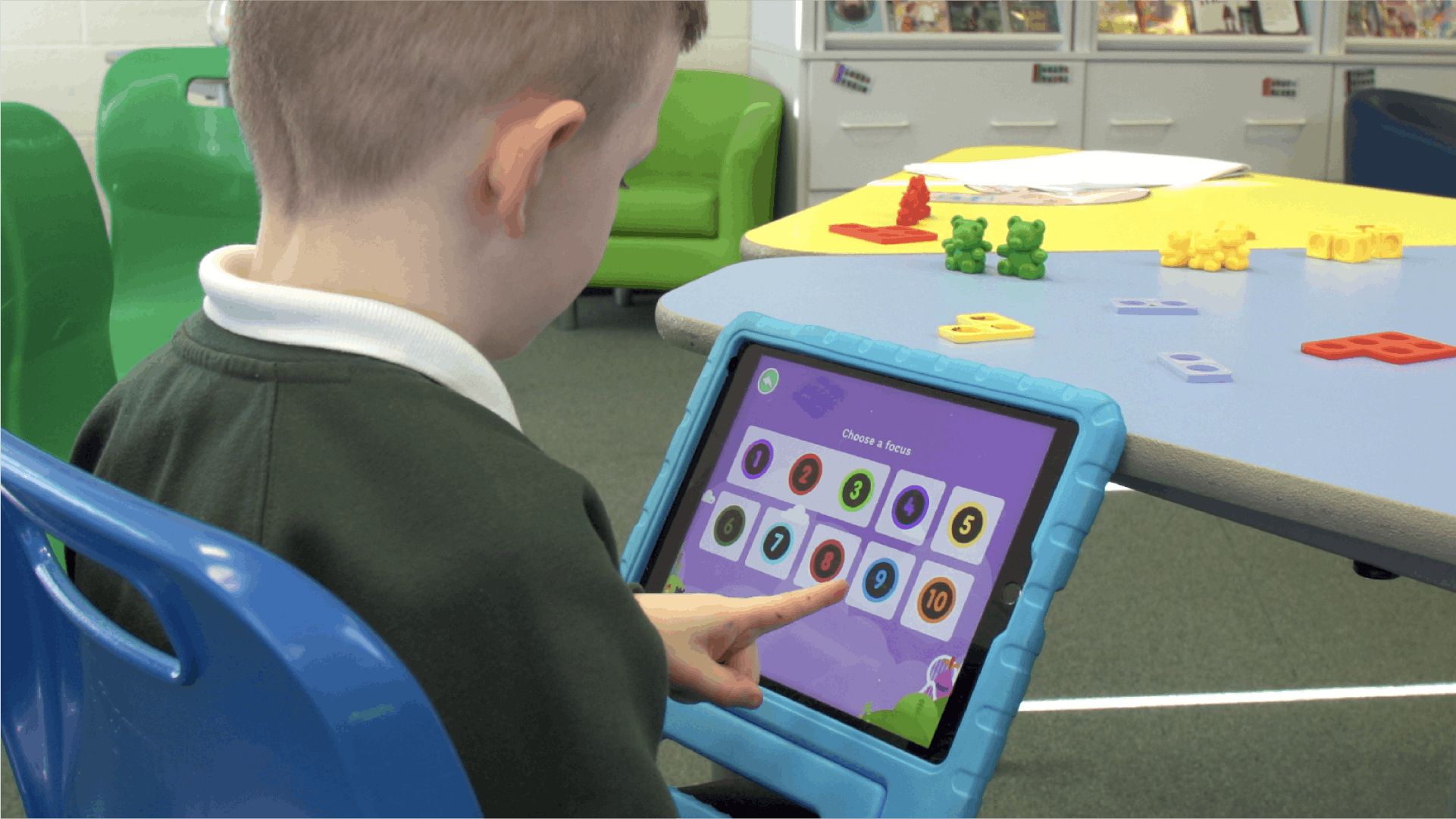Using our games in the classroom
Here we share a few different ideas on how to use and integrate Teach Your Monster games in the classroom. We've gathered these ideas from our teacher super users, and hope you'll find new and exciting ways to get kids excited for a 'Teach Your Monster' lesson or maybe even give you 5 minutes to get ready for the next lesson!
To discover what each game covers, find out more here: game-by-game comparison.
General ways to use our games in the classroom
Carpet time
During carpet time, the teacher can select a game to demonstrate playing on the interactive whiteboard and then allow the children to take turns or come up in pairs to play.

If you’d like to lead the learning (and keep bottoms on carpets!), you can give each child a whiteboard to use and ask the children questions like:
For Number Skills: “Which number comes next? Write it in secret on your whiteboard”
For Teach Your Monster to Read: “How do you write this grapheme? Can you think of any other ways to write it?”
They can respond on whiteboards and show you when they’ve finished.
Use for individual learning (where children have access to individual devices or laptops)

Set up children with their own profiles and take their monster through the game—this allows kids to play at their own pace and recap necessary skills. For brand-new players, you can demonstrate the log-in and game on the interactive whiteboard first, then allow them to explore independently.
One of our super fans, teacher Lori Cash, recommends peer-to-peer help for new players or selecting game ‘prefects’ to teach other kids how to play.
Teachers can ask children to go to ‘Practice Mode’ during individual play for a particular skill, game, or number, providing targeted practice on weaker skills.
Use in a carousel, centres or ‘learning stations’

If you like to set up ‘stations’ for learning, one station could be set up for ‘e-learning ’ with devices to practice a specific subject using one of our games. If you’re unsure what ‘stations’ are, read more about them in this handy article.
For example, at reading time, this station could be Teach Your Monster to Read for early readers, or Reading for Fun for more progressed readers.
Read more about stations under the game-specific sections below.
We have a whole bunch of handy printables for the stations in class, find those here.
Use as an intervention tool

Many teachers have reported the usefulness of our games to engage those students with different needs or English as an additional language (EAL) needs. Our games are built with animations as well as verbal instruction, which allows some kids to access more easily through visual prompting and stay engaged through fun gameplay.
Teachers can ask additional questions while students are playing to encourage explanations of what and why they are doing things in the game as they play.
Reward time

The best part is that playing our games feels like reward time — kids love iPads, and what better thing to do with reward time than some more sneaky learning?
One teacher advised using iPad time as a specific reward for kids with individual behaviour charts (for challenging behaviour). She stated, 'Each week, we would pick a specific focus, for example, staying in their seat, and every lesson this happened, a sticker would go in their chart, and 5 stickers meant 10 minutes of iPad time. Of course, the iPad had just Teach Your Monster games, so I knew they would be learning in their reward time, too!
Transitions between breaks and lessons
Another teacher, Adam Samuel, recommends using the game after break times: “I often use it to settle in back down after break time or lunch time. It's a really nice way to kind of gently bring them back in after what could be a nice fraught break or lunch.”
Depending on what lesson you have next, tailor your transition time to the following lessons - got an afternoon of math? Transition with a quick Number Skills session.
Printables

Did you know we have a whole bunch of helpful, fun and FREE resources based on our games in our Learning Resources area? These bring our games offline and into your everyday classroom Check them out here.
Specific activities
Teach Your Monster to Read
Carpet time

Phonics Revision: Using the 'Flashcards' in Practice Mode, select all the relevant GPCs for your class and ask children to call out the phoneme matching the displayed grapheme. Alternatively, hide the screen and ask the children to write the matching grapheme to the phoneme they hear. Reveal the sounds at the end of the session.
Sighties Revision: Have a speed round using the 'Sighties' game in Practice Mode, kids can help one plucky volunteer to read and select the matching 'tricky word' at the interactive whiteboard.
Reading Stations/Centres
We recommend using Teach Your Monster to Read for developing early reading skills and phonics. The E-learning station is set up with Teach Your Monster to Read, either with specific goals in mind using ‘Practice Mode’ or more free play time through the Adventure Mode.
If using Practice Mode for the reading station, we recommend providing a game or a GPCs focus for your students, whether individually or as a group. For more information about how 'Practice Mode' works, you can play the game first or visit our Teach Your Monster to Read Practice Mode information page here.
We’ve provided a free Teach Your Monster to Read printable download for your e-learning table, where you can write your GPC focus for the lesson.
Reading for Fun
Carpet time

Use our game Reading for Fun to select a book and read together as a class for a nice, calming activity. Teachers can be pretty hands-off with this if you get a ‘lucky helper’ from the class to turn the page, and it is very good if you need 5 minutes to set up for the next activity of the day.
Reading Stations/Centres

In this E-learning station, children can play through Adventure mode independently or pick a book from their in-game bookshelf to read quietly with a partner. You can check their comprehension with questions as you monitor the classroom.
Number Skills
Carpet time

Choose a skill or number to practice on the interactive whiteboard together as a class as a quick brain break or warm-up activity. Let children choose or be more focused on practising a particular skill in 'Practice Mode'. For more information about 'Practice Mode', visit our Number Skills Practice Mode information page here.
Children can call out answers, hold up the correct number of fingers or write on their individual whiteboards to show after a countdown.
Math Stations/Centres

The E-learning station would be set up with Number Skills, either with specific goals in mind using ‘Practice Mode’ or more of free play time through the Adventure Mode.
We’ve provided a handy printable for you to download and print for your focused Number Skills station here. We recommend inputting the skill, number or game you'd like the students to recap on this printable in the centre of the learning station.
Songs

Our Number Skills songs from the game are available to watch on YouTube or stream on Spotify, for a quick brain break activity.
Adventurous Eating
Carpet time

Adventurous Eating can be used to encourage the trying of new fruits and vegetables, which could be particularly useful during snack time. Throughout the game, the monsters are encouraged to try new foods using all their senses, and this is based on research that improves childhood eating habits. In 'Practice Mode', you can now select a particular food for Bub to try, and allow the kids to try the same.
For more information about 'Practice Mode', visit our Adventurous Eating Practice Mode information page here.
One teacher we interviewed had particular trouble with the kids trying mango, so she showed them how the monsters use their senses to try in the game.
Healthy Eating or Science Lessons

Adventurous Eating is also perfect for PSHCE lessons around healthy eating or science lessons around life cycles.
For a Healthy Eating lesson based on trying foods with your senses, we have provided a Healthy Eating Activity Pack, with printouts for each table or a slideshow for the whiteboard, along with keywords to improve vocabulary around food tasting. All you need to do is provide the food!
Other great printables can be found in our Adventurous Eating Printables section in our Learning Resources area.
Play the growing game in Adventure mode to show a sped-up version of a plant's lifecycle, from planting the seed to harvesting the root vegetable.
Sing-a-long brain break

Use the 'Disco' mode in 'Practice Mode' to find all of our great vegetable songs. Sing and dance together for a quick and funky brain break!
Other songs from the game are available to watch on YouTube or stream on Spotify.